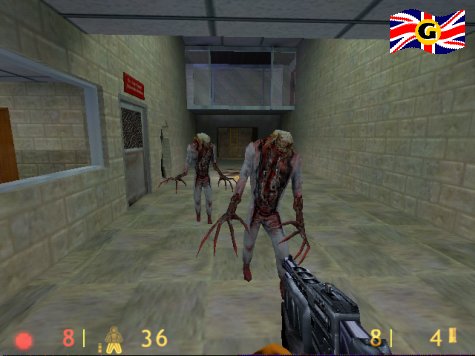

Contact Me
|

Half Life
A major goal in any game is to create the illusion of reality, a
fact that is especially true for first-person shooters. The whole point of the genre is to
put you, literally, in the role of the protagonist. In light of this, it's surprising that
so many games have stuck to a blueprint that breaks the illusion at every possible
opportunity, with text-based mission briefings, jarring level transitions, and weapons and
power-ups scattered around like decorative furniture. But Valve Software has obviously
spent a lot of time studying the mistakes of the past. The result is Half-Life, the
closest thing to a revolutionary step the genre has ever taken. Through a series of subtle
and artistic design decisions, Half-Life creates a reality that is self-contained,
believable, and thoroughly engaging. And while it may be surprising that no game has
utilized any of these ideas in the past, it's clear that any future shooter will be remiss
to overlook them.
The plot of the game is typical (in fact, it's little more than an elaborate version of
Doom). You are Gordon Freeman, scientist at the Black Mesa Research Facility, involved in
some mysterious experiments. These experiments go awry, and foul creatures begin taking
over the complex. It gets more complicated, but there's no need to ruin the surprises that
await. Suffice it to say that Half-Life isn't a great game because of its story; it's a
great game because of how it presents that story. From the opening moments of the game to
the final showdown (and even beyond) all hell is continually breaking loose, and there is
never a moment where you are not seeing things through Freeman's eyes. There are scripted
events in the game. There are opening and closing scenes. But they all occur naturally
within the game environment. It may sound simple, but it goes a long way toward helping
create a believable world.
Weapon, ammunition, and health placement follows the same philosophy. You'll hardly ever
come across an item that is just bobbing and spinning in place like some gift from the
heavens. Valve has done a good job of justifying the typical health and armor meters.
Freeman is wearing a hazard suit, used by researchers involved in dangerous experiments.
To regain health and armor energy, you must fill up at power stations. These are almost
always located in logical places, usually near areas where dangerous work would be
performed. There are no power-ups to be found. Weapons and ammo are taken from supply
closets or the corpses of fallen security guards and soldiers. Even the more experimental
weapons have their proper place - in the weapons research department of the facility. And
late in the game, once you've left the research facility, the supply of ammo and first aid
kits is believably scarce.
There are no levels in Half-Life, or, more specifically, it lacks the concept of levels
and episodes we've come to expect. The game is a continual stream of locations from
beginning to end. You can move back and forth at will (with only a few exceptions), as can
those who are pursuing you. And though the brief loading time between zones is the one
artifact that breaks the flow of the game, the transitions are thankfully brief.
The attention to detail doesn't just stop with the basic structure. The game is full of
surprises, continually throwing new obstacles and challenges in your path. There is a wide
variety of textures, lending a distinct look to every area. The numerous scripted events
bolster the illusion of reality, and you'll come across detailed scenes that are
continually suspenseful. The gameplay is very puzzle-oriented, but the puzzles hardly seem
to be superficial obstacles. Whether you're repairing a reactor or finding some way to
dispose of a massive locked door, the puzzles always seem plausible in the world Valve has
created.
The alien enemies are well designed and occasionally border on the terrifying. From the
basic headcrab (which resembles a cross between Alien's facehugger and X-COM Apocalypse's
brainsucker) to monstrosities a hundred times its size, the enemies truly look like
organic beings. There are human enemies in the game, and these display a level of
artificial intelligence that is remarkable. While many a game's idea of excellent AI is
simply monsters that can make it through a doorway to follow you, Half-Life's antagonists
act in a manner that is frighteningly realistic. They won't follow you through a doorway -
they'll just lob a few grenades to where you're hiding and be done with it.
The weapons look and sound great, ranging from the realistic combat shotguns and grenade
launchers, to the science-fictional, high-powered particle accelerators. The level design
is diverse (owing a nod of thanks to Jedi Knight), including the expansive research
facility, some great outdoor areas, and foreign locales that are best left to be
discovered on your own. Suffice to say, it never gets repetitive.
The only problems with Half-Life are the results of it being so ambitious. The fact that
all of the humans in the game look like clones takes from the otherwise realistic
atmosphere. The diversity of the levels and puzzles will undoubtedly leave you thinking
some areas were better than others. But complaints that arise are simply a reaction to the
fact that the game is so close to ideal. Half-Life is an exceptional single-player game
and a solid multiplayer game (though the upcoming Team Fortress add-on may make it even
better). It takes the tried-and-true one step further but ends up leaps and bounds ahead
of the rest.
Score: 9.4/10
|

Courtesy : GameSpot
|





